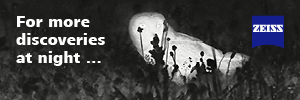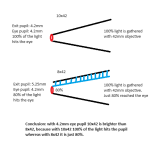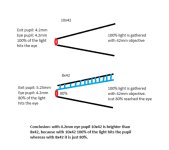Let‘s assume two binoculars of the same quality:
8x42
10x42
The 10x is only 20% dimmer and gives 25% more detail, as long as your eye pupil did not exceed 4.2mm.
Because of higher magnification the 10x is 56.25% dimmer as the 8x (quadratic effect), BUT the 10x concentrates the same incoming light (both are 42mm, also quadratic effect of the size of the aperture) across a smaller exit pupil, so there is an effect that the light is 25% more concentrated (brighter) for the 10x. Thats why the 10x is just 20% dimmer than the 8x of same quality, as long as your eyes pupil is not bigger than 4.2mm.
But the effect of 25% more detail of a 10x against an 8x is slightly more important at low light than a brighter image IMHO:
In low light your eyes are not resolving as good as at bright day. So a binocular that prefers detail over brightness is slightly better to actually see detail at all.
There are types of hunting where you hunt from a hide at close range, just a few meters (lets say 10-30 meters or so), then the detail you get from an 8x might be enough to see that animal but you might not be able to tell if it‘s a male or female or what age the animal has.
(I am not a hunter, I just did some math)












